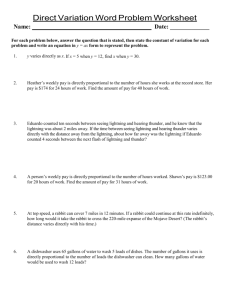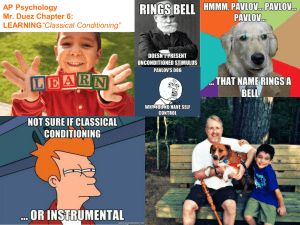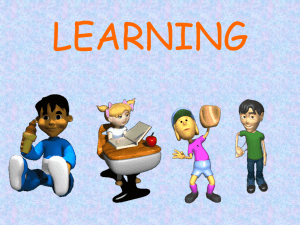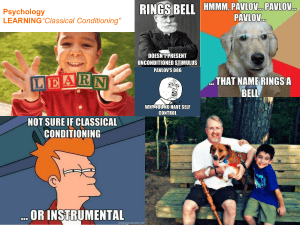Chapter 6: LEARNING *Classical Conditioning*
advertisement
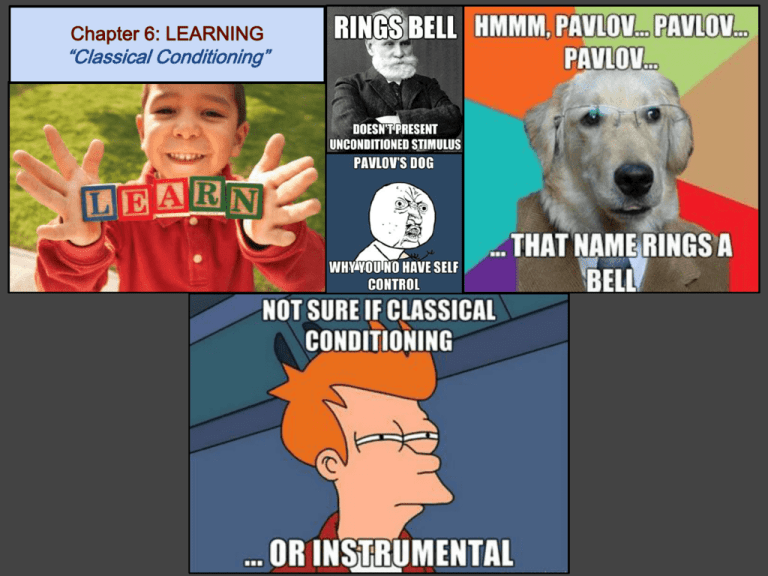
Chapter 6: LEARNING “Classical Conditioning” What is Learning? Most learning is... Associative Learning: Realization that certain events occur together. Learning: A relatively durable change in behavior or knowledge that is due to experience ★ Classical Conditioning ★ Operant Conditioning ★ Observational Learning (Latent, Abstract, Insight) Classical Conditioning Ivan Pavlov developed the framework for CC: Learning to associate one stimulus with another, i.e. “Stimulus-to-Stimulus Learning” “Next time there is a revolution, get up earlier!” Annenberg: Discovering Psychology: Program 8 - Learning. How is the fear of lightning a simple classical conditioning situation? At any one time, all around the world, there are 2,000 thunderstorms happening, producing over a 100 lightning strikes a second. That's over 8 million lightning bolts every day unleashing the power of 2 million tons of TNT. We associate 2 stimuli: We see lightning... & then hear thunder. (speed of light is faster than the speed of sound) Lightning ... THUNDER Lightning ... THUNDER Lightning ... THUNDER Eventually, you see lightning & then flinch... anticipating the second stimulus. You have paired lightning & thunder. You have learned that when there is lightning, thunder may follow. We associate 2 stimuli: We see lightning... & then hear thunder. (speed of light is faster than the speed of sound) Lightning ... THUNDER Lightning ... THUNDER Lightning ... THUNDER Eventually, you see lightning and then flinch... anticipating the second stimulus. You have paired lightning & thunder. And you have learned that when there is lightning, thunder may follow. Unconditioned Stimulus (UCS): Unconditioned Response (UCR): A stimulus that naturally & automatically triggers a response. The unlearned, naturally occurring response to the UCS. Conditioned Stimulus (CS): Conditioned Response (CR): An originally irrelevant stimulus that, after association with the UCS, comes to trigger a response. The learned response to a previously neutral stimulus. We associate 2 stimuli: We see lightning... & then hear thunder. (speed of light is faster than the speed of sound) Lightning ... THUNDER Lightning ... THUNDER Lightning ... THUNDER Eventually, you see lightning & then flinch... anticipating the second stimulus. You have paired lightning & thunder. And you have learned that when there is lightning, thunder may follow. UCS: ? UCR: ? NS: ? CS: ? CR: ? After repeated episodes.... creating ‘Conditioning’: UCS: Thunder UCR: Fear NS: Lightning CS: Lightning Pairing UCS & CS = CR: Fear The Office - Classical Conditioning Pavlov… not so impressed. Jim asks, 'Do you want an altoid?' Dwight reaches out his hand. Computer tone Computer tone Dwight reaches out his hand. ...UCS ...UCR ...NS ...CS ...CR YouTube: Classical Conditioning Examples with Chuck Schallhorn Pavlov spent the rest of his life outlining his ideas. Discovered 5 critical terms that together make up classical conditioning: ★ ★ ★ ★ ★ Acquisition Extinction Spontaneous Recovery Generalization Discrimination Acquisition The initial stage of learning. The phase where the neutral stimulus is associated with the UCS Therefore the neutral stimulus comes to elicit the CR, thus becoming the CS. Does timing matter? The CS should come before the UCS They should be very close together in timing. Extinction The diminishing of a conditioned response. Will eventually happen when the UCS does not follow the CS. Is extinction permanent? Spontaneous Recovery Reappearance. After a rest period, of an extinguished conditioned response, the conditioned response returns. Generalization The tendency, once a response has been conditioned, for stimuli similar to the CS to elicit similar responses. Stimulus generalization from a circle to an ellipse: Dogs also would salivate to the sight of an ellipse. Thus, for these dogs, the CR of salivation to the sight of a circle showed stimulus generalization to the ellipse ( Shenger-Krestovnika, 1921) The classical conditioning theory of phobic disorder states that the learned fear to a CS generalizes (transfers) to other stimuli, with the greatest amount of transfer occurring to stimuli that are most similar to the CS. Discrimination Learned ability to distinguish between a CS & other stimuli that does not signal UCS. As described on the last slide, dogs showed stimulus generalization to the sight of an ellipse when they had been classically conditioned to salivate to the sight of a circle. If one continued to pair the circle with meat but never paired the ellipse with meat. Over time, the dogs stopped salivating to the ellipse but continued to salivate to the circle. That is, the dogs were able to discriminate between the ellipse and the circle, and learned that they received meat only after seeing the circle (Shenger-Krestovnika, 1921) Classical conditioning theory of phobic disorder: individuals learn to discriminate between a CS that is followed reliably by a fear-inducing UCS & stimuli that, although similar, are rarely or never followed by the UCS. For example, in the case of the dog that is fearful of all men because it has been treated cruelly by a particular man, it probably will learn to feel fear only to the man who abused it if most other men the dog meets treat it kindly. Difference between Stimulus Generalization & Discrimination How would you define stimulus generalization in your own words? How would you define stimulus discrimination in your own words? John B. Watson - Classical Conditioning Founder of Behaviorism. Took Pavlov’s ideas and put them to new & more rigorous tests. “Little Albert” & Generalization Watson demonstrated that he could create fear in a child in response to a neutral stimulus (a rat). Paired a rat with a fear-inducing stimulus (a loud noise), the child eventually became fearful of related stimuli = Generalization YouTube: Little Albert Footage UCS UCR NS CS CR - Loud Noise Fear, crying, madness, misery Rat Rat Fear John B. Watson in his experiment with Little Albert, an 11 month old baby, studied how emotions are learned. He presented a white rat (NS) & a loud noise (UCS) to Little Albert. After several pairings, Albert showed fear (CR) of the white rat. Later, Albert generalized the fear to stimuli that were similar to CS, such as a beard. After conditioning… Is this study ethical? Standards set by the National Commission for the Protection of Human Subjects of Biomedical and Behavioral Research (late 1970s): Watson's experiment would not have been allowed for numerous reasons including its unethical context. It is now measured immoral to evoke reactions of fear in humans under laboratory circumstances, except if the participant has given an informed approval to being purposely horrified as part of the experiment. After conditioning… Is this study ethical? Experiments should not cause human participants to suffer unnecessary distress or be physically harmed. Welfare of human participants must always be the paramount consideration in any form of research, & this is especially true with specially protected groups such as children. “Albert” or Douglas Merritte died on May 10, 1925 of hydrocephalus (developed in 1922). Condition was congenital (from birth). Hydrocephalus ("water on the brain") : Abnormal accumulation of cerebrospinal fluid (CSF) in the ventricles, or cavities, of the brain. May cause increased intracranial pressure inside the skull & progressive enlargement of the head, convulsion, tunnel vision, & mental disability. “Little Albert” was a very ill infant who, perhaps because of the hydrocephalus he had had since birth, could not see well &, according to his relatives, never learned to walk or talk. There is evidence that John B. Watson knew of this illness. Watson & Rayner's (1920) report reveals little evidence either that Albert developed a rat phobia or even that animals consistently evoked his fear (or anxiety) during Watson and Rayner's experiment. It may be useful for modern learning theorists to see how the Albert study prompted subsequent research [...] but it seems time, finally, to place the Watson and Rayner data in the category of "interesting but uninterpretable" results.




